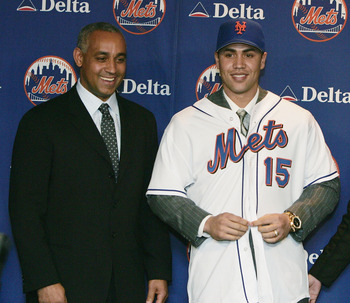
This offseason, we’re looking at the Mets’ history with free agency. The No. 3-ranked entry was Billy Wagner — a dominant closer beginning in 2006. Next up was another member of that ’06 club, who remains still under-appreciated for his standout and steady play at the plate and in the field.
He parlayed an astounding 2004 playoff performance into a free-agency bidding war.
New Mets general manager Omar Minaya, like other team executives, was enamored with the mastery Carlos Beltrán demonstrated on the October stage as a Houston Astro. It included eight homers, 20 hits, a .435 batting average, and an on-base percentage above .500. All this came following a stellar regular season that saw him eclipse 30 home runs for the first time in his still-young career and surpass the 100-RBI barrier for the fifth time in his six years.
Who was to fault the Mets to froth over the prospect of a 27-year-old switch-hitting, five-tool center fielder teamed with a pair of up-and-coming infielders named David Wright and José Reyes along with fellow free-agency pickup Pedro Martinez?
For fans who suffered through a third straight season well below .500, no price — not even $119 million over seven years — was too much. Beltrán went on to average 30 homers, 108 RBIs, and 39 doubles (per 162 games). Before surgery wreaked havoc on his knee, he was among the most successful and timely baserunners, stealing around 20 a year at an 84 percent clip.
But the most downplayed aspect of his well-rounded talents was his defense. Beltrán’s range made him an elite center fielder and a three-time Gold Glove recipient. He got to would-be hits gracefully, not acrobatically. His speed and his knack for reading the ball off hitters’ bats afforded him the ability to glide over to catches more often than sliding.
He did all that after a rough debut year in which he set career lows in just about every major offensive category, including batting average (.266), homers (16), runs driven in (78), and stolen bases (17).
He rebounded in terrific fashion. Beltrán etched his name into franchise history when he equaled the Mets’ single-season home run mark at 41, a record that would stand for 13 years. He also drove in a career-high 116 runs as New York cruised to the NL East title. He finished fourth in MVP voting but was clearly the most valuable Met with an 8.2 WAR that was easily the highest on the team.
New York’s consecutive end-of-season unravelings were not the fault of their center fielder. Beltrán was one of the few Mets who never caved under the late-season pressure. He tried to right a sinking ship in September ’07 by launching eight homers and driving in 27 runs (more than he had in any other month that year). In September 2008, he hit .344 with an on-base percentage of .440 and an OPS of 1.086.
Injury-riddled 2009 and 2010 seasons preceded another All-Star-caliber year in 2011 (with a 151 OPS+) before being dealt to the San Francisco Giants at the trading deadline for pitching prospect Zack Wheeler.
Carlos Beltrán would (and should) make most Mets’ all-time starting lineups, but most fans can only remember that one pitch — a patented wicked curveball from Adam Wainwright — in October 2006.
The context of when it took place makes it the moment we most associate with Beltrán. To use it as a defining moment is an oversimplification. A wide-lens view of his Mets career proves — despite the grand expectations laid upon him from the start—that while he was understated, he wasn’t an underachiever. Regardless of his NLCS-ending strikeout or the circumstances that led to his abrupt managerial career, Beltrán’s Mets legacy should be as the best center fielder this team has had and among the most significant free-agent signings.















